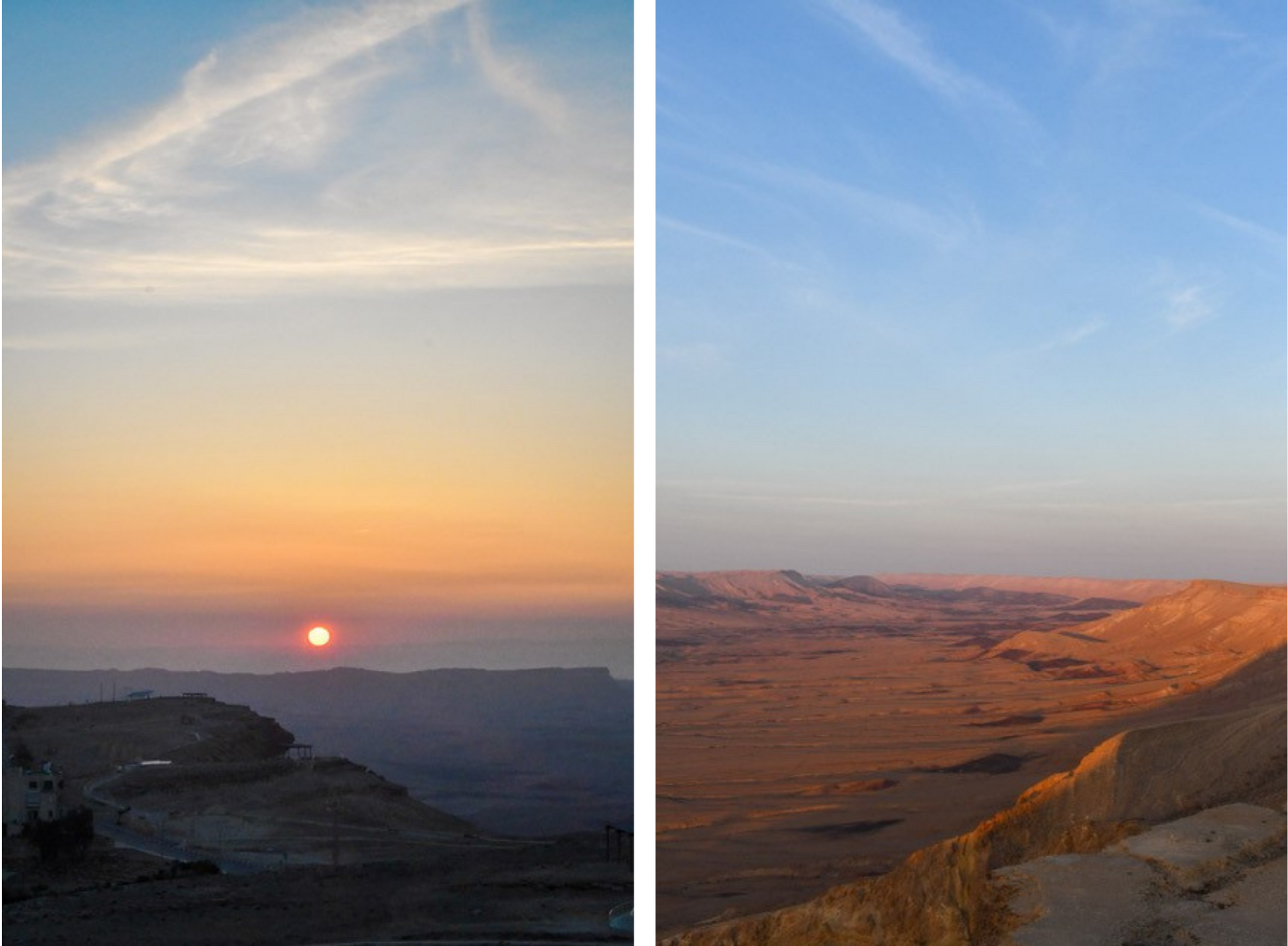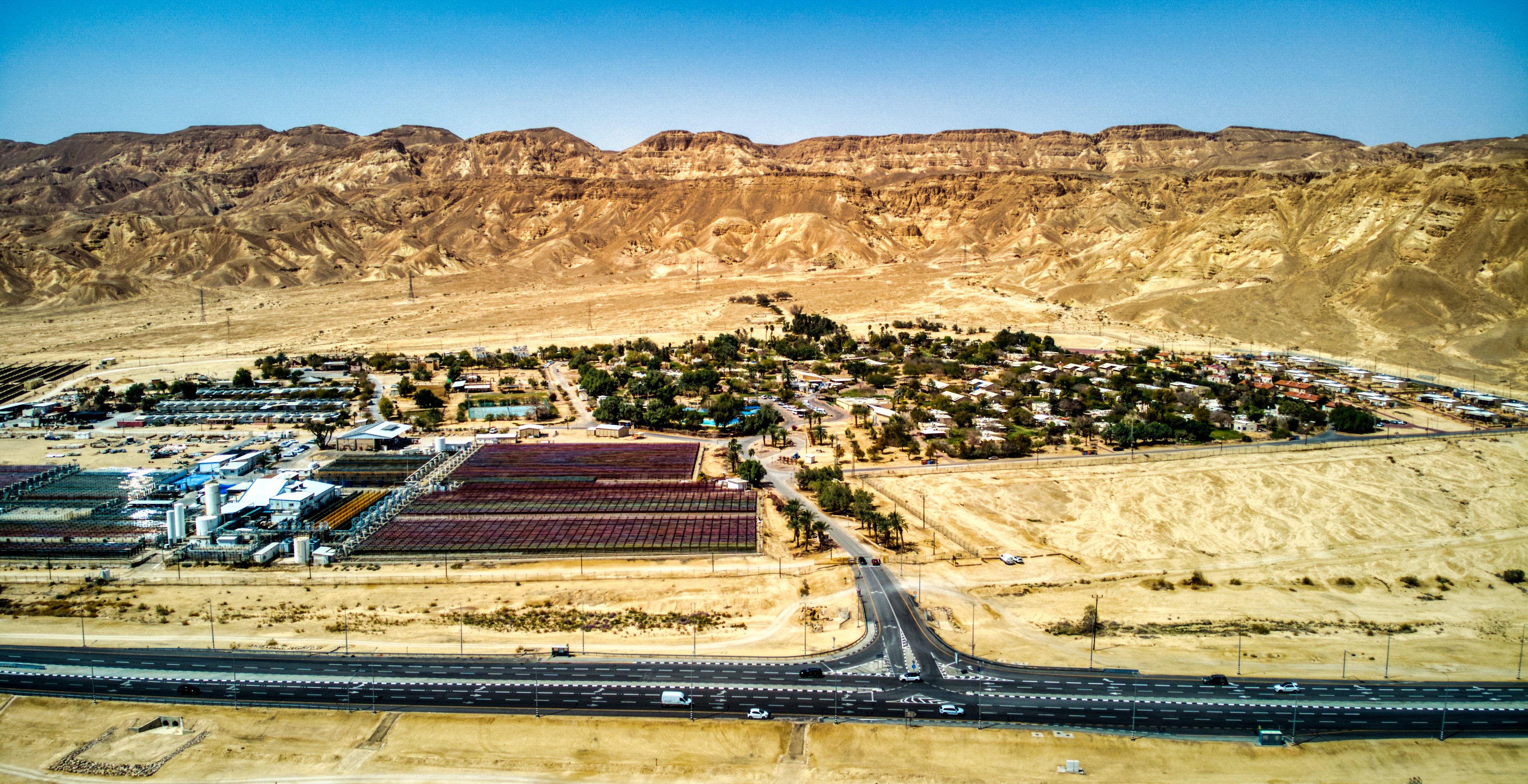Day Seven – From Sunrise to Scorpion Hunting
By: Payton Ramsey '25
This article is part of a series of reflections prepared by students enrolled in the Texas A&M School of Law 2023 Global Field Studies Program: Israel. Click here to visit the entire series.
Day 7 started early for myself and a handful of my classmates. We elected to wake up around 5:30 AM to walk to Camel Mount, a nearby observation point we hoped would give us an unbeatable view of the sunrise. We followed the trail from our hostel, enjoying the view of the Ramon Crater and passing some of the Nubian mountain goats, or ibex, which roamed the area. Finally, we arrived at Camel Mount just before the sun came over the horizon, and sat in silence as it rose and colored the crater gold.

The view of the sunrise and the Mitzpe Ramon Crater from Camel Mount.
We then returned to the hostel, where we ate breakfast, packed our bags, and loaded the bus. To reach our next destination, Kibbutz Ketura, we traveled through the Ramon Crater and deeper into the Negev Desert. Just before arriving at the Kibbutz, we stopped at an observation point overlooking the Arava Valley. Below us was the Kibbutz, neighbored by a shining solar field and orchards of date trees so green they looked black. On the other side of the valley lay the Jordan border, with the mountains beyond it obscured by a dusty haze.
We then traveled down to Kibbutz Ketura itself, where we received a tour of the community. The Kibbutzim are collective communities in Israel first formed by Zionists in the early 20th century. Traditionally, the Kibbutzim were heavily involved in agriculture, though today many have branched out into other industries. There are about 270 Kibbutzim in Israel now, with Ketura being one of them.

Kibbutz Ketura (thanks to Wikipedia)
While the traditions and unique customs of each Kibbutz vary, Ketura is an income-sharing community where the members share a fleet of cars and take meals in a communal dining hall. Rather than receiving a salary, the members of the Kibbutz receive a budget based on their family size. Ketura is involved in traditional agriculture—producing and selling dates—but it is also involved in producing and selling cosmetology products.
Also unique to Kibbutz Ketura is that within its borders is the Arava Institute. The Arava Institute is a research institute focused on addressing environmental concerns that also hosts academic programs. Undergraduate and graduate students can participate in either semester-long or year-long programs at the Institute and take environmental courses there. But, the academic program at the Institute offers students an opportunity to learn something beyond environmental sciences. The students, who are from Israel, Palestine, and other countries around the world, including the U.S., also meet each week to engage in an open dialogue where they discuss the ongoing Israeli-Palestinian conflict and other related issues. These meetings allow each of the students to share their personal experiences and views, and to foster empathy and understanding for one another.
After our tour of the Kibbutz, we sat down with a panel of students attending the Institute. They shared with us that the conversations that really lead to empathy and understanding occur after their weekly dialogue, rather than during it. They explained that after their weekly meetings, the students have a greater understanding of where a divide lies. They then have the ability to choose to converse about it further and bridge that divide. Ultimately, the students are actively deciding to have tough conversations about their views and beliefs so that they can each achieve a greater understanding of one another.
After a meeting with Dr. Clive Lipchin to further discuss our research project and dinner with other Arava Institute students, we moved on to our highly-anticipated, final activity of the night: scorpion hunting. Scorpions glow a blue-green color when under an ultraviolet or black light, and they can be found near the Kibbutz Ketura. So, after a quick briefing, we set out from the Kibbutz and headed into the desert, armed with blacklights and ready to find glowing scorpions.
After twenty minutes of trekking through treacherous desert terrain in the near-dark, I was about ready to give up, but then… Success! While I never found a scorpion that night (I’ll choose to blame it on my weak blacklight), I luckily had classmates and tour guides who were better than me. We first found a native species of scorpion that was about the size of a dime. Afterward, we found several more, including a larger species that would take up about half of your palm. Each of them glowed under our lights, a stark blue-green against the dark ground. Finally, once we were done pestering the local scorpions, we made our way back to the Kibbutz and called it a night.

One of the scorpions we saw “glowing” under the blacklight.
Looking back on this experience, I am so grateful I had the opportunity to attend the trip to Israel. Over the course of the trip, we saw so much and learned from several speakers, many of whom are working hard to make positive changes and improve lives through their respective careers. Ultimately, I look forward to carrying this experience with me as I enter my legal career, and I would recommend any student considering participating in a field course to apply to attend.
Learn more about Texas A&M University School of Law's Global Law and Policy Program, Aggie Dispute Resolution Program, and Energy, Environmental, and Natural Resource Systems Law Program
